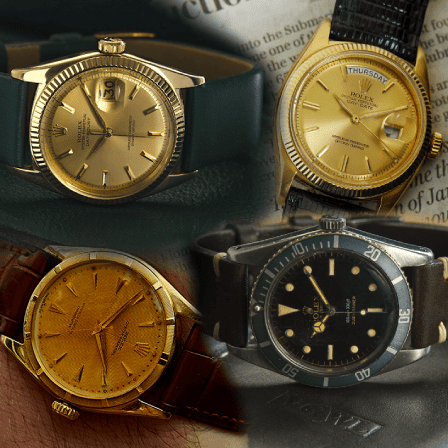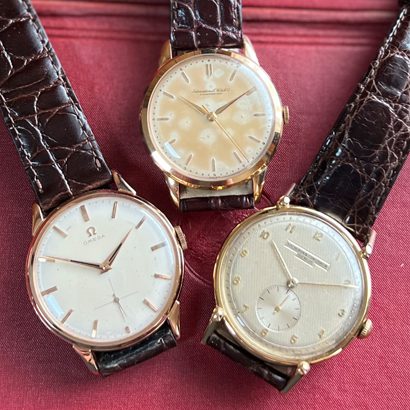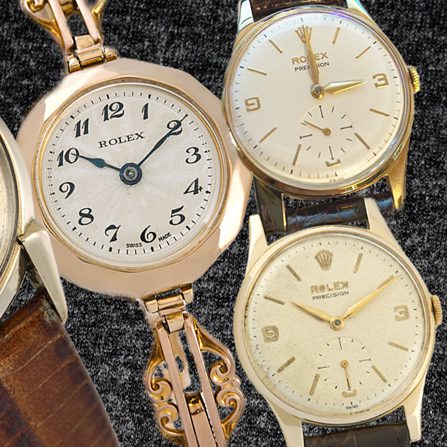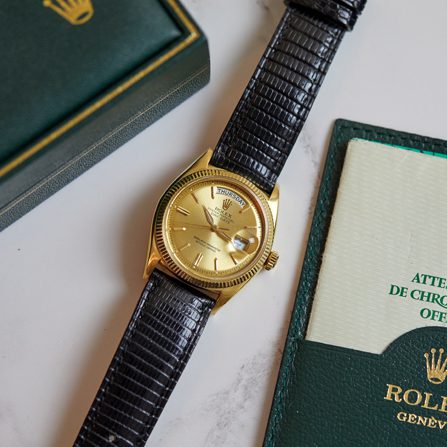
ARE RADIUM WATCH
DIALS DANGEROUS?
Radium was used on watch and clock dials for over fifty years. This means there are thousands out in the market for the collector to purchase, but are radium dial watches dangerous, and why was radium used at all?
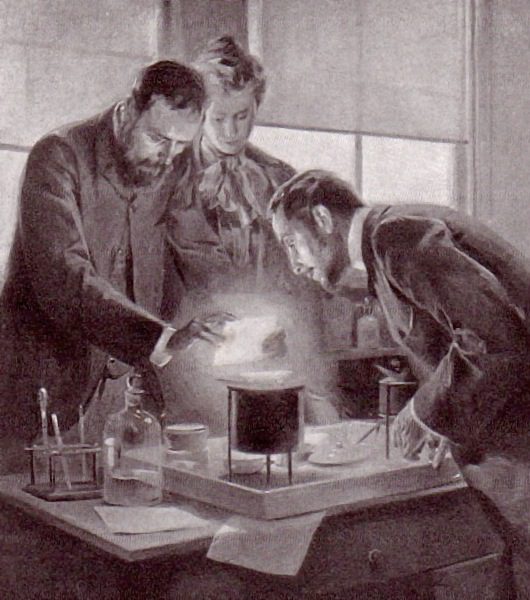
The Need for Light
A watch is only as good as its ability to tell you the time. This means that early watches, however finely made or accurate, were daytime timepieces. Before widespread public and domestic lighting, ‘night’ meant dark until morning. A chiming clock might mark passing hours if you were rich or close enough to a church. Chiming watches, known as repeaters, were only available to the privileged rich.
The substance that put the ‘time’ into night-time was discovered by Marie and Pierre Curie in 1898. Radium is a curious element, consistently warmer than its surroundings due to the radiation it emits, but what suited it to watchmaking was the fact that it glowed. This meant it could be used to impregnate the hands and dials of watches and clocks, making them glow at night. Luminous paint was invented in 1902 by William J Hammer, who first mixed radium with zinc sulphide, but he failed to patent his creation and lost out to George Kunz at Tiffany & Co., who did.

Radium - The Wonder Element
Although Radium glows blue in the dark, it is not exceptionally bright. Its property as a radioactive particle emitter was most useful on dials and hands, with these particles causing other ingredients in the paint to glow by a process known as radioluminescence. The glowing component is known as a phosphor, although, confusingly, phosphorous is not a phosphor and emits light by a different chemical reaction known as chemiluminescence.
Radium is an unstable element, always looking to decay into a more stable form. This decay process releases the radioactive particles known as alpha and beta, along with gamma rays. Radioactive elements emit a variety of mixes of radiation with different consequent effects.
Radium produces alpha and beta particles and gamma rays but is primarily an alpha emitter. These particles excite zinc sulphide to create that typical green glow of radium lume. The alpha particles also break down the phosphor much quicker than the beta particles, so the glow fades to nothing after a few years. Don’t be fooled; with a half-life of 1600 years, the radium in the paint is still emitting like crazy, but there is no phosphor left to interact with. UV light may elicit a brief glow, but there will be no lasting luminosity.
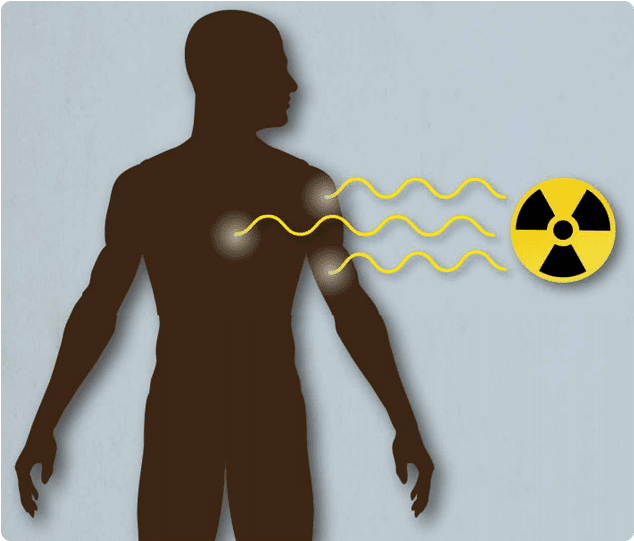
Radiation and Health
Radiation can seriously affect human health, and these effects vary depending on the type of particle emitted. All radiation has an ionising effect, changing the chemical composition of cells, damaging them, and even leading to cancer.
There are three major types of radiation to consider here:
1. Alpha particles:
Alpha particles cannot penetrate most matter. A piece of paper or the outer layers of skin is sufficient to stop alpha particles.
Radioactive material that emits alpha particles (alpha emitters) can be very harmful when inhaled, swallowed, or absorbed into the bloodstream through wounds.
2. Beta particles:
Beta particles can be stopped by a layer of clothing or a few millimetres of a substance such as aluminium.
Beta particles are capable of penetrating the skin and causing radiation damage, such as skin burns.
As with alpha emitters, beta emitters are most hazardous when they are inhaled, swallowed or absorbed into the bloodstream through wounds.
3. Gamma rays and X-rays:
Gamma rays and X-rays are penetrating. Several feet of concrete or a few inches of
lead are required to stop them.
Gamma rays and X-rays are a radiation hazard for the entire body. While gamma rays and X-rays can easily pass completely through the human body, some fraction of the energy will always be absorbed by body tissue.

The Dose is the Key
As with other toxins, “the dose makes the poison”
We receive low doses of radiation from our natural environment every day, especially from areas of granite rock or from long-haul aircraft flights. We know that radiation at high doses can cause cancer, harm foetuses, and even lead to death.
Factors That Affect Dose
A dose received over a long period is less harmful than the one received all at once. A dose to a part of the body is less harmful than a dose to the whole body. Children and young adults are more sensitive to the effects of radiation.
How Radiation Affects Your Body
Radiation can damage the DNA in our cells. High doses of radiation can cause Acute Radiation Syndrome (ARS) or radiation burns. High doses of radiation could also lead to cancer later in life.
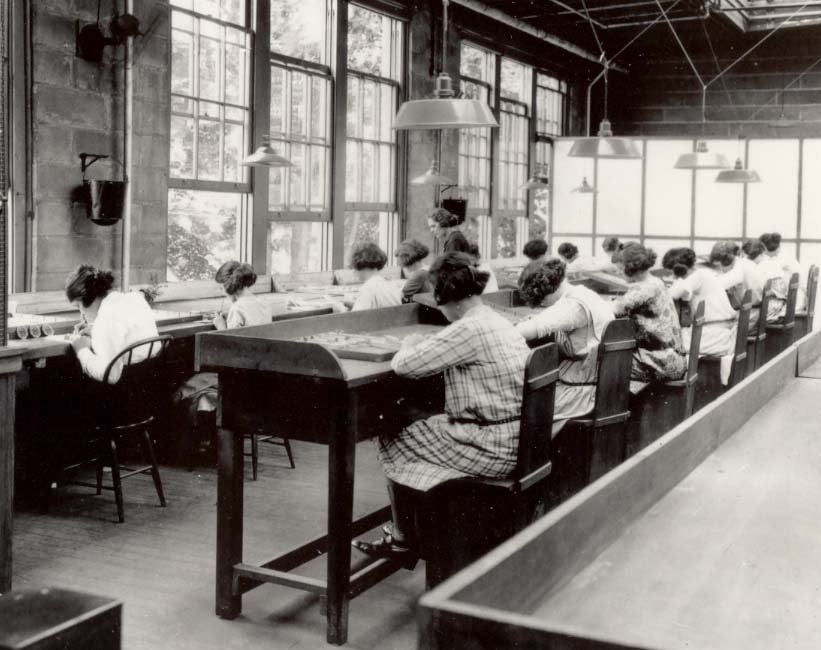
Radium and Dial Painting
The hazardous consequences of Radium were identified only two years after its discovery. Despite this, the early 20th century saw an outbreak of ‘Radium Fever’. As with former discoveries such as magnetism and electricity, it was offered as a health-giving cure-all. Radium-laced toothpaste, face cream and even underpants were sold, all with dreadful effects.
Early use of radium paint was most widespread in Switzerland where, to quote Ross Mullner – author of ‘Deadly Glow’, “there were so many radium painters in that country that it was common to recognise them on the streets even on the darkest nights because of the glow around them: their hair sparkled almost like a halo.”
The USA began using radium paint in 1914, bringing its toxic effects to the workplace. In the case of the ‘Radium Girls’, women who worked at three dial-making facilities were told that the luminous paint was harmless by their managers. In addition to daubing each other for fun, they pointed their brushes for delicate work by licking the bristles. In doing so, they ingested lethal amounts of radium.
Using brushes in this way, a practice derived from ceramic painting, was rare in Europe where glass pens or wooden styluses were used. The manufacturers denied liability and suppressed medical evidence accusing some of the victims of contracting syphilis. Eventually, the women proved their case and the fact that the management knew of the risks. Radium continued to be used until the 1960s, but with new safety measures being followed, workplace contamination stopped.

The Use and Decline of Radium Dials
Initially, radium dials were expensive, so their use was reserved for the military, finding their way onto the clocks and gauges of aircraft cockpits and other military timepieces such as pocket and wristwatches. With demand reduced in the inter and post-war periods, civilian watches also had their numerals and hands enhanced with radium-infused paint.
While public health concerns were an issue, watch manufacturers were also keen to prolong the life of the luminous paint on watch dials and hands, and so a search for a less aggressive radioactive source began. Elements such as strontium and promethium were used, which, while less harmful than radium, still posed a risk before the watch industry widely adopted tritium in the 1960s.
Over the years, the amount of tritium was reduced with ‘T<25’ showing that the emission was less than 25 mCi (millicuries) and, finally, the ‘T Swiss Made T’ that signifies emissions below 7.5 mCi. In 1993, Japanese paint company Nemoto & Co. created a ground-breaking luminous compound named Luminova. Made from strontium-aluminate, this material was radiation-free, brighter, and more long-lasting than any previous zinc-sulphide-based paint.

Collecting Radium Dial Watches
It is unusual for collectors to focus on watches with radium dials and hands, but an interest in vintage watches from 1910 to 1960 will inevitably bring such watches into consideration. The distinctive blackened lume dots and star-burst dial ‘burn’ of this Rolex Oyster Perpetual 14ct Model Ref. 6084 from 1952 show the untouched originality of the watch that collectors appreciate. Many military watches had their luminous material changed from radium to tritium at service, so to find a watch in its original condition is more rare and valuable.

Guidance for Ownership
Experienced vintage watch collectors are usually relaxed about radium dial watches, but new buyers may read the history of radium and ask themselves, ‘Are radium dial watches dangerous?’. The answer is ‘no’, as long as sensible guidelines are followed.
Remember, alpha particles are large, slow-moving, and easily stopped. Most will never pass the crystal or case back of your watch. A Geiger counter reading on the crystal may be higher than the surrounding atmosphere. Still, the reading will drop off a few centimetres above the watch or behind the case’s back.
Here are some tips on how to handle a radium dial watch:
- Protect your watch crystal – this contains the radioactive paint and its associated dust.
- If your crystal gets cracked or broken, wrap the whole watch in plastic, wash your hands, and then contact a specialist repairer with experience with radium dials such as Vintage Gold Watches
- Remember, inhaling or ingesting radium paint dust is the most dangerous risk, so be wary of any radium dial without a crystal, especially if browsing antique shops or watch fairs. Military dials used far more radium than civilian watches, so issued watches or aircraft clocks without crystals are a particular concern.
- Working on a radium-dialled watch yourself is risky. Care must be taken not to release any dust into the room. Good ventilation and scrupulous handwashing are essential.
- While originality in watch collecting is valued, if the paint on your dial or hands is crumbling, it may be time to consider a sensitive restoration with a non-radioactive alternative.
- If a watch or clock with a radium dial is beyond repair, it can legally be disposed of in domestic rubbish as the amount of material is so small. First, offer larger dials or many watches to an experienced watchmaker aware of the risks. Contact a specialist radioactive and hazardous waste disposal firm if there is no interest.

Guidance for Storage
Unless you are a WWII MOD Quartermaster, or your vintage watch collection is enormous, the risk of storing several vintage radium dials watches together is negligible. Still, the presence of radon gas is an important consideration.
Radon Gas
Radon is a colourless, odourless gas that is the natural product of radioactive decay. It occurs as small amounts of uranium naturally found in rocks, such as granite, decay. The decay of radium also produces radon. It is a radioactive material in its own right, and being a gas can easily be inhaled or ingested. In nature, concentrations rarely build to harmful levels, but stagnant air trapped underneath houses can cause problems as levels build. Long-term radon exposure can lead to breathing problems and lung cancer.
The active radium in the dial and hands of a vintage watch produces radon in small quantities. This will leak out of the case as they are not hermetically sealed. The solution to radon in houses is good ventilation. Houses in badly affected areas have small fans installed in basement areas to circulate the air and prevent radon build-up. If you store several vintage watches together in a box or safe, it is a good idea to open the door regularly and take them out. This will disperse any radon and prevent health problems. While you have your watch out, why not take the opportunity to wear and appreciate it?
Radium Dials, Caution Rather Than Fear
Radium is a dangerous substance, there is no question about that, but the use of radium in watch dials reduces the risk significantly. Trapping the radium between the watch movement and its crystal contains the risk. It allows collectors to enjoy watches from the first half of the 20th century, a golden age of watch manufacture, in their original, unaltered condition.
Following a few basic rules on handling and storage will mean you are exposed to less radiation than a week’s holiday in Cornwall, UK or a transatlantic flight. If you have questions about purchasing or owning a radium-dialled watch, talk to the experts at Vintage Gold Watches.
Sign up for our regular newsletter if you would like to learn about the world of vintage watch collecting.

OTHER BLOGS

